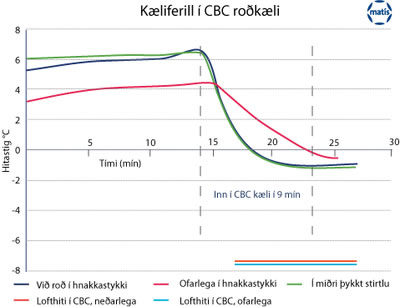Matís is working on studies of the effects of pre-cooling products before packaging with regard to the shelf life of products. The closer the product is to the optimum temperature during packing, the smaller the need for refrigeration in the actual transport process.
It is very important to lower the temperature of the product in small units before packing, otherwise there is a risk of slow and uneven cooling, as is the case with large packed units. The pre-cooling methods used in the experiments are liquid cooling and skin cooling, and the products are packed in a foam plastic box after trimming and cutting into nape pieces. The boxes are stored in temperature-controlled conditions where the actual transport processes are simulated. Changes in quality and damage processes are monitored at regular intervals. The results will then be used to assess the shelf life of products that have been packaged after or without precooling.

These pre-cooling experiments are useful for two AVS projects, i.e. Integration of refrigeration research (R 061-06) and Simulation of refrigeration processes (R 037-08) and are also part of the EU project Chill-on (FP6- 016333-2). In the first project, they are used for more purposeful process management and the publication of guidelines for the industry. In Simulation of cooling processes, more emphasis is placed on the transport processes and the connection between pre-cooling and the design and use of packaging in transport processes. The results of the pre - cooling experiments are useful in the development of heat transfer models for fresh fish in transport, which are used to improve transport processes.







